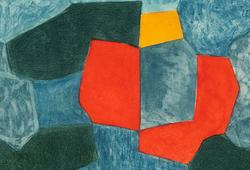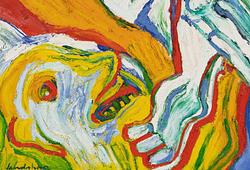Anders Zorn
Grandmother
Signed Zorn and dated -?6. Indian ink on paper, image 52 x 35 cm.
Provenance
Swedish publisher Joseph Seligmann (1836 - 1904).
Literature
The Swedish publication "Ord och Bild, volume 30, 1921, illustrated (from the estate of Dr Joseph Seligmann).
More information
The tender portrait in ink of Anders Zorn's grandmother, Hass Karin Andersdotter (1811–1894), was likely executed in 1886 – the same year Zorn was working on the commission from Nationalmuseunm for the large motif "Vårt dagliga bröd". The large watercolour depicts the harvesters' work on one of the Grudd family’s fields in Mora. In the foreground, Zorn's grandmother, Hass Karin Andersdotter, dominates as she prepares a meal for the workers. She is dressed in the warm winter coat made of fur – part of Dalarna's traditional winter costume – and a recurring garment in Zorn's portrayals of her.
In the portrait now being auctioned, grandmother Hass Karin Andersdotter stands proudly and upright in one of the family’s fields, her gaze firmly fixed on the viewer. Zorn has, with the etcher's quick and confident strokes, skillfully captured her characteristic features, the intense gaze, and the soft drape of the costume. It is a portrait charged with emotion, reflecting Zorn's close ties to his family and homeland in Dalarna.
As an only child, Zorn grew up with his mother and his grandparents. His life would be marked by successes, commitments, and international assignments, but it was in Mora that he found his anchor. Here, Zorngården was built, where the Mora cottage – the grandparents' original home – became an integral part of the house. There was also the large timbered hall, whose scale had no equivalent in the region. Zorngården became a symbol of the poor son’s return. Next to the farm was Zorn's studio, set up in a medieval firehouse from the mountain farm Fåsås.
For Zorn, the traditional costume became a way to preserve and make visible the cultural heritage he feared would be lost in the age of industrialism. In his paintings, he had the models – often from the Grubb and Skeri families – wear older costumes, even when they were no longer used in everyday life. He wanted to evoke childhood memories and bring to life the local traditions that had shaped him. The details of the costumes – fur coats, headscarves, bodices, and skirts – were rendered with great precision, not as romanticised folk art or nostalgic glow, but as living expressions of a cultural identity.
Photo: Hass Karin Andersson. Photo: H Andersson, Mora, 1883. Zorn Museum's archive ZFO0699.
Artist
Anders Zorn, born in Mora in 1860, showed artistic talent from a young age. In 1875, he traveled to Stockholm and became a student at the then Slöjdskolan (now Tekniska högskolan) in Stockholm, and shortly after, he joined the Royal Academy of Fine Arts. Initially, Zorn had aspirations of becoming a sculptor, but soon watercolor painting took over, becoming his primary medium until 1887. At the student exhibition in 1880, Zorn had his breakthrough with the watercolor painting "I sorg." The following year, he gained international acclaim as a portrait painter. His watercolor painting reached its pinnacle during this period, and his most famous work from this time is "Vårt dagliga bröd” from 1886. Shortly thereafter, Zorn transitioned to oil painting, which was met with immediate success. Zorn's reputation mainly rested on his portrait art, and he portrayed many notable figures, including presidents. For instance, he created an etching of Theodore Roosevelt. His etchings significantly contributed to his success. In the late 1880s, Zorn began working in the genre that would increasingly become his trademark: nude figures in outdoor settings. He had long been fascinated by the movement of water and the reflections of light on its surface. Now, he added the complexity of placing a model near or in the water, aiming to depict a synthesis between nature and humanity. In 1896, Zorn and his wife moved back to Sweden and settled in Zorngården in Mora. This move sparked a renewed interest in his homeland, which would be reflected in his future paintings. Among the artist's scenes from the Mora region, portraying its local customs and ancient traditions, "Midsommardansen" holds the highest value according to Zorn himself. Today, the painting can be found at the National Museum.
Read more






































